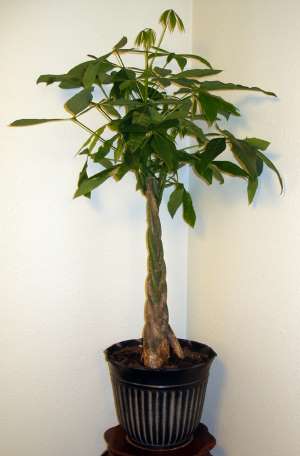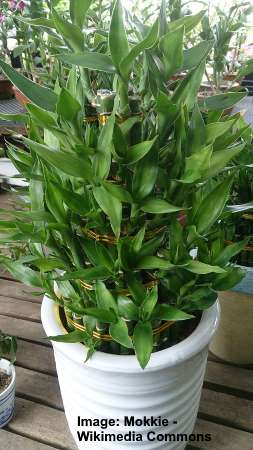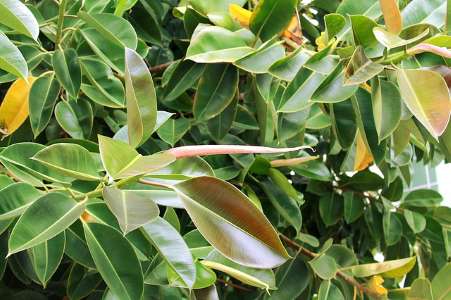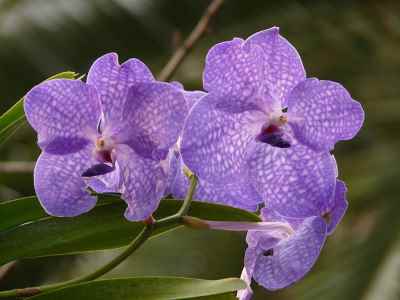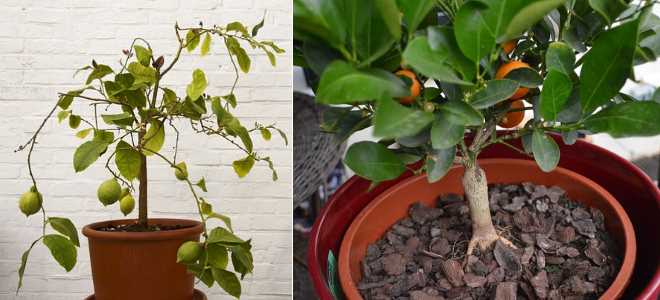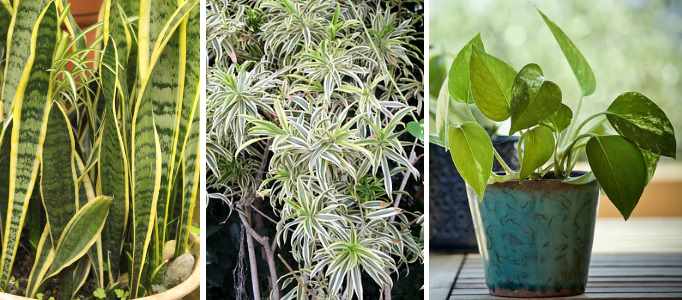Plants that Bring Good Luck, Prosperity and Fortune (Lucky Plants) Says Feng Shui
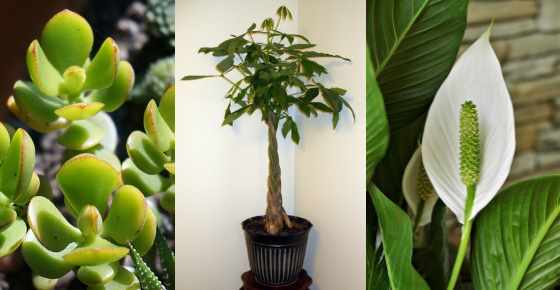
According to Feng Shui, there are certain types of plants that are classed as good luck plants. Feng Shui plants are said to bring prosperity, fortune, love, and luck. That is why some types of “lucky plants” are called money trees or money plants. There are other plants Feng Shui considers to bring luck such as lucky bamboo, rubber plants, orchids, and some types of indoor ferns and palms.
Having a number of houseplants is good to help purify the air in your home and improve humidity. Feng Shui says that certain plants help to balance the water element and result in displacing negative energy. There is also scientific research showing that indoor plants can help reduce stress. Other studies have shown that plants have a generally positive effect on a person’s well-being. (1, 2)
In this article, you will learn about the Feng Shui good luck plants that may bring you good fortune, prosperity, and even happiness.
Good Luck Plants to Bring Good Fortune, Wealth, and Health According to the Feng Shui
Let’s look in more detail at the Chinese “lucky plants,” starting with the 2 of the most popular ones – the money plant and money tree.
Money Plant (Crassula Ovata)
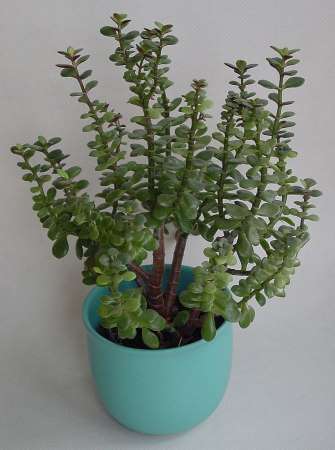
The money plant (Crassula Ovata) brings good luck, fortune, and wealth according to the Chinese Feng Shui
Feng Shui dictates that certain types of jade plants from the genus Crassula can help bring prosperity and good fortune. The jade plant species Crassula ovata is also called the money plant, dollar plant, cauliflower-ears, or money tree. It is said that the coin-shaped leaves of this Feng Shui plant symbolize wealth.
Although called a money tree, the Crassula ovata Feng Shui plant shouldn’t be confused with the true money tree Pachira aquatica.
Jade plants are a type of succulent that have tree-like stems, smooth branches, and thick fleshy leaves. The succulent leaves are jade green, and some cultivars may have red or yellow edges. These ovate-shaped leaves can grow up to between 1” and 3.5” (3 – 9 cm) long and up to 1.5” (4 cm) wide.
If you are fortunate, money plants may start flowering in winter. Small pink or white star-shaped flowers appear and give off a sweet scent. Jade plants will usually flower when the environment is right in winter months. This usually happens when nights are longer, the weather is colder, and the plant doesn’t get water for a few weeks.
In some cases, money plants can grow up to 8 ft. (2.5 m) tall and look like a large shrub-like tree. However, money plants that grow indoors will rarely reach these heights.
Apart from hoping to increase your fortunes, one of the reasons to keep jade plants in the home is due to their hardiness. Like many succulents, jade plants don’t need a lot of care or maintenance. In fact, some studies show that jade plants may live for upwards of 100 years. (3)
Money plants are usually gifted to new business owners or placed in offices to invite success or wealth. These money plants are also easy-to-care-for houseplants that can help create a natural well-balanced indoor environment.
Money Tree Plant (Pachira Aquatica)
One of the Feng Shui plants said to attract money is the appropriately named Money Tree Plant. This ornamental houseplant is a species of tree in the genus Pachira belonging to the family Malvaceae. You will often see pictures of this money tree plant (Pachira aquatica) with braided trunks growing in containers.
Similar to jade plants, the money tree plant is said to invite fortune, wealth, and prosperity. This is one reason why is it also termed a “money plant.” However, apart from their connection to Feng Shui, jade plants and the Pachira aquatica are not related in any way.
Legend has it that the money tree plant became an auspicious plant when a poor man prayed for money. He then came across this strange-looking plant. He viewed this as a lucky tree when he started making money selling the plants he grew from seeds.
The Money Tree plant is also called the Guiana Chestnut, French Peanut, Provision Tree, and Saba Nut.
As an ornamental Feng Shui lucky plant, the central trunk is usually made up of between 3 and 7 braided stems. The top of the stems has large shiny green leaves in the shape of a lance tip (lanceolate). Money trees usually grow to between 3 and 6 ft. (0.9 – 1.8 m) tall. Usually, the indoor varieties of money trees don’t flower.
Followers of Feng Shui place Pachira aquatica money trees in homes or businesses to attract good fortune, prosperity, and wealth.
Lucky Bamboo (Dracaena Sanderiana)
Lucky bamboo is said to be an auspicious plant for the home that summons fortune, happiness, and prosperity. The type of Feng Shui lucky bamboo is the species Dracaena sanderiana. Other names for this lucky charm houseplant include Chinese water bamboo, Goddess of Mercy, and Sander’s dracaena.
Although this plant looks like bamboo, it is not in the same family as true bamboo Poaceae. As an attractive ornamental houseplant, the plant has long straight fleshy stems that sprout long leaves. The bamboo-like stems can grow up to 3.2 ft. (1 m), but in Feng Shui, shorter variations of the “bamboo” plant are preferred.
To look after your lucky bamboo, cut the stems back every so often. This will help direct energy back into the stalk and leaves and it will continue growing healthily. Occasional pruning and keeping them in small containers will help restrict the height.
Feng Shui lucky bamboo plants are usually sold in glass containers or pots with just rocks and water. You will find that the plants thrive just as well in water as they do in soil. This makes lucky bamboo one of the easiest houseplants to care for. If you keep these “good luck” plants in just water, add some liquid fertilizer every month and avoid topping up with tap water but use filtered water or rainwater.
Feng Shui says that the number of bamboo stalks has different meanings when it comes to inviting fortune. It is said that 3 stalks represent happiness, wealth and long life. 5 or 6 stalks can mean wealth and good luck. And, 7 stalks can symbolize good health.
Rubber Plant (Ficus elastica)
Choose a rubber plant to help purify the air and help introduce balance to your living environment. Feng Shui says that the Ficus elastica species attracts wealth, prosperity, and good luck. Other names for this indoor good luck tree include rubber fig, Indian rubber bush, or rubber bush.
The Rubber tree plant is one of the many types of indoor ficus tress. It’s a member of the family Moraceae which means this good luck is related to figs. Ornamental rubber plants have large thick oval leaves that can be in a range of colors. Some types of Ficus elastica have shiny green leaves, some have variegated yellow or creamy-white and green leaves, and other types have burgundy red leaves.
Strategically placing a rubber plant can help to create a natural, stress-free environment in a room. The potted indoor rubber plant grows between 6 to 10 ft. (180 – 300 cm) tall and it’s perfect for small rooms or offices.
In Feng Shui, it is said that plants with rounded leaves such as the rubber plant are associated with positive energy.
Find out how to grow and care for rubber plant (Ficus elastica).
Orchids
Orchids are not just beautiful to look at, according to Feng Shui they also enhance luck when it comes to the family. According to some sources, violet orchids are the most auspicious plants from all the thousands of types of orchid.
Many Feng Shui plants are just green-leaved types of shrubs or trees. So, orchids really stand out among them as the most attractive of all the “lucky plants” available. Orchids are also a symbol of love and beauty in many cultures. In Feng Shui, they symbolize happiness, better relationships, and enhanced fertility.
There are thousands of orchid hybrids and cultivars to choose from. Some of the most beautiful orchids that are easy to care for are Paphiopedilum and Phalaenopsis orchids. These can have just plain white flowers to help promote feelings of calm and peace. Or, brightly-colored orchids can help represent passion, energy, and creativity.
Most types of indoor houseplant orchids have large thick leaves growing at the base of the stem. Long stems emerge from the center of the plant and large flowers grow along the length. Many orchid flowers tend to have around 5 petals that can be oval-shaped or lance-shaped. However, there are many variations in the thousands of orchid hybrids.
Orchids can make beautiful gifts for new families or to promote harmony for anyone in a relationship.
Peace Lilies (Spathiphyllum)
Peace lilies are a great addition to any room to help clean the air and evoke a sense of harmony. Feng Shui says that peace lilies help to bring about good luck and fortune. Its elegant large green leaves and brilliant white flowers help to create a pleasant atmosphere in any room. Some people describe peace lilies as a “good luck plant for purifying the air.”
It’s not just advocates of Feng Shui that claim peace lilies are an air-purifying plant. A 1989 NASA study listed peace lilies among the plants that help purify the air. The study found that clean-air plants such as peace lilies help get rid of formaldehyde and benzene from the air. (4)
Although these attractive plants have the word ‘lily’ in their name, they aren’t true lilies from the family Liliaceae. Peace lilies are a genus of flowering leafy plant in the family Araceae. The most outstanding features of lilies are their large dark green leaves and pure white flowers. Their leaves can grow up to 25” (65 cm) long and be up to 10” (25 cm) wide. These are contrasted with white flowers having a single petal that can be between 4” to 12” (10 – 30 cm) long.
You can place peace lilies anywhere where you need to improve air quality. These can be especially useful in offices or on office desks.
Citrus Trees
Growing citrus trees in containers indoors is another way to attract money, and good luck according to the Chinese Feng Shui. Lucky plants like citrus trees are claimed to bring good luck and prosperity to the home. Some Feng Shui followers use citrus trees for their gardens. However, there are many ornamental orange, lemon, and lime trees that you can grow inside your house.
Indoor citrus trees can be small shrub-like plants that grow in small pots. Or, you can train a citrus tree to grow taller if you want a taller plant in a room. Ornamental citrus plants are great for kitchens or they can add a touch of elegance to any other room. Feng Shui says that the best types of citrus trees for good luck are dwarf lime trees or lemon trees.
Parlor Palm (Chamaedorea Elegans)
Indoor palms also have a place in Feng Shui culture as an air purifier and to improve balance. One of the best small types of palm for your home décor is the parlor palm (Chamaedorea elegans). As its botanical name suggests, the parlor palm is an elegant variety of palm. It is also one of the most popular types of houseplants in the world.
When growing indoors to help create positive energy, the parlor palm grows up to 2 ft. (60 cm) tall. The shrubby plant has thin stems with large fern-like leaves growing on them. One of the reasons why parlor palms are so popular is because they require little maintenance. The plant seems to grow just as well in low humidity as it does in high humidity. It can also tolerate dark conditions where other types of houseplants would have difficulty growing.
Another reason why parlor palms are a good choice if you practice Feng Shui is that they are versatile for any type of room. For example, the trailing nature of the light green leaves makes them excellent for hanging baskets. These can be placed at front doors or anywhere else where you want to improve your living environment. Or, you can put a tall parlor palm in a corner to help add a touch of elegance to your living space.
Boston Fern (Nephrolepis exaltata)
Boston ferns are another important air purifying plant that help create a sense of positivity in any room. Also called the sword fern, fishbone fern, and wild Boston fern, this species of fern is one of the most welcoming plants you can have.
Boston ferns can beautify any type of room with its long trailing leaves. The Feng Shui fern can grow to between 16” and 35” (40 – 90 cm) tall. The fern fronds (leaves) can grow to between 0.6 and 8 ft. (0.5 – 2.5 m) long. This large bushy plant is excellent in hanging baskets or for filling up space on top of a wardrobe, shelf, or plant stand.
Other Types of Plants Feng Shui Says Bring Good Luck
Apart from the most popular plants that are used in Feng Shui, there are some other plants that are said to bring good fortune:
- Sansevieria Snake Plant is a type of succulent with long sword-shaped leaves that is claimed to be a bringer of luck and also help purify the air.
- Spider plants also have air-purifying properties and can help to relieve stress and improve concentration.
- Golden pothos (Epipremnum aureum) is another type of good luck plant that many say brings them good fortune.
Related articles:

